Hey there brothers and sisters of iron, Tony here with another detailed review. This time we’ll take a look at a luxury item of sorts with a somewhat valuable feature of an automatic hand off of a loaded barbell (and unloaded too if you start your warm ups with just the bar first)… This is none other than the infamous monolift attachment! (or mentioned sometimes by their nickname monos as they are called by the lifting community…not to be confused with the kissing disease of the same name).
Table of Contents
Intro to Monolifts
Much in the way the spotters inside the power rack reign supreme in keeping you safe from a heavy loaded bar potentially crushing and/or steam rolling you on a failed lift, the monolift attachment hooks will give you a proper hand off of the bar when lifting alone and the hooks will get out of the way as well due to the “Counter weight balance” mechanism conveniently built up top on the attachment when the bar gets un-racked from the hooks.
I almost went with Rogue’s, but landed up getting a custom pair of these from the builder Mech6 from the workout equipment forums who had built my power rack at the time (mentioned in one of my previous articles), he had one more pair of monos left and I lucked out and got ’em. There are many types of monolift attachments out there, but my particular pair are the adjustable/non-bolt on version in 2X3 with 5/8″ pins (including the hitch pins for the bottom portion of the attachment to reassure no twisting, or play of the attachment can happen and will keep them flush on the uprights).
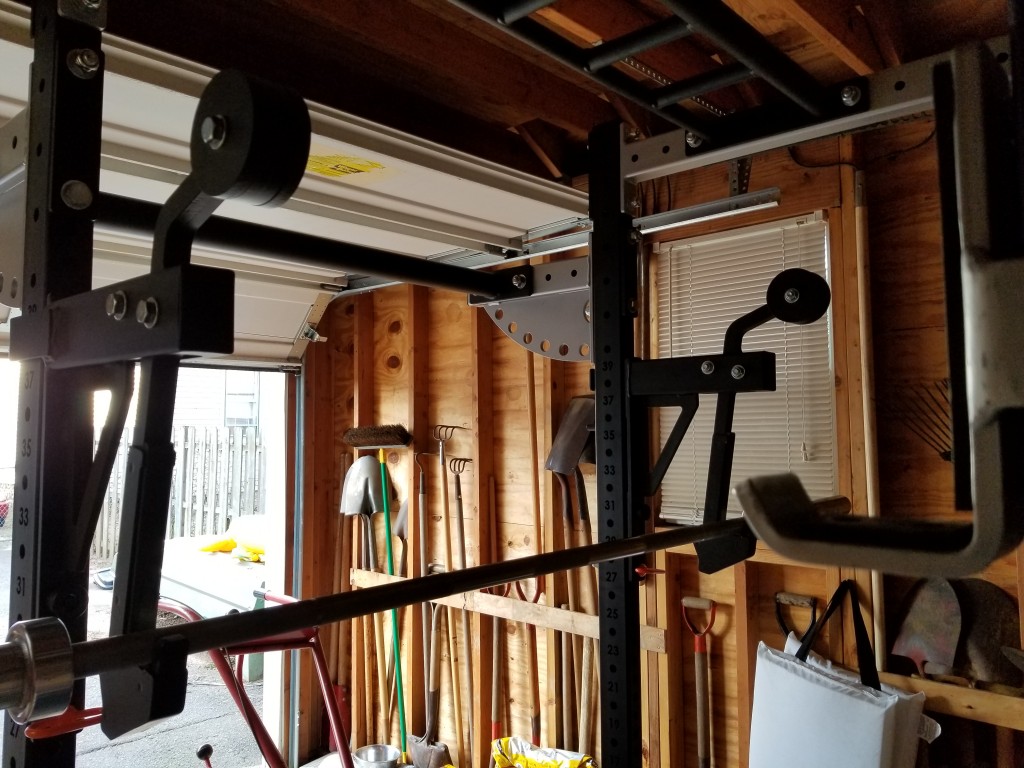
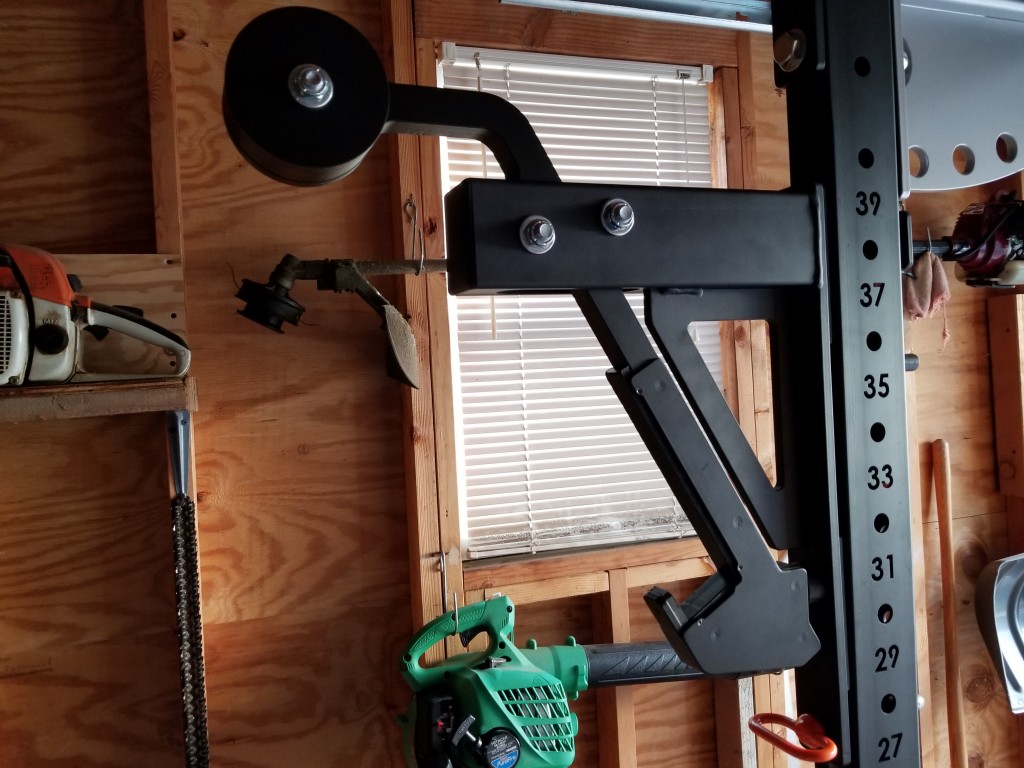
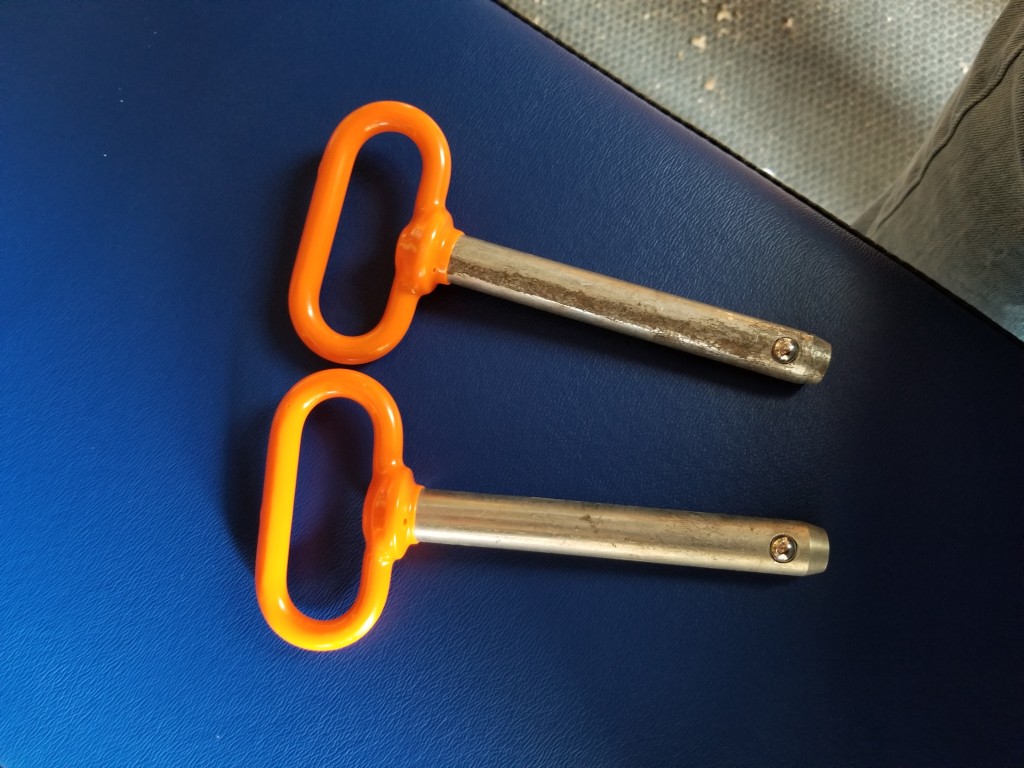
Features, Dimensions and Technical Specifications
Here’s some features, dimensions and technical specs of the monolift attachment I own (note, that these dimensions may slightly vary depending on which monolift attachment you go with)…
- 2X3 adjustable monolift attachment 5/8″ pins and hitch pins.
- Bracket is made of 3/8″ thick steel with the tube part being 11 gauge.
- Arm is 1″ thick.
- Vertical length of the monolift attachment upright when attached to the power rack upright is 19″ long.
- Horizontal length of the monolift attachment upright bar is 12″.
- If the mono hooks have no barbell racked in them the hooks are 7″ in length from the uprights and the counter weight portion up top sticks out at 18″ from the uprights.
- If a barbell is racked in the mono hooks, the hooks go forward 3″, making the hooks go out to 10″ all together, and the counter weight portion up top goes back 2 1/2″, making it stick out at 16 1/2″ from the uprights.
There’s UHMW lined all around the hooks contact points, including the back where the upright sits flush against the rack upright and is lined inside where it wraps around the upright and a rubber stopper where the mono hooks contact to protect the upright front portion of the monos when un-racking and the hooks swing back.
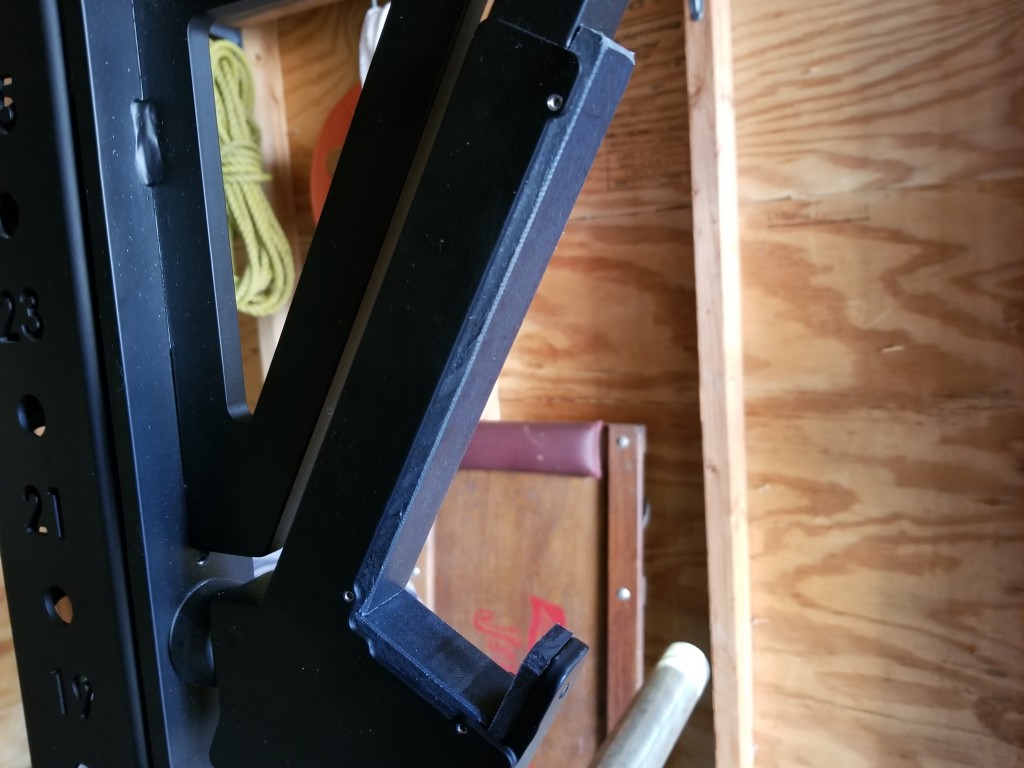
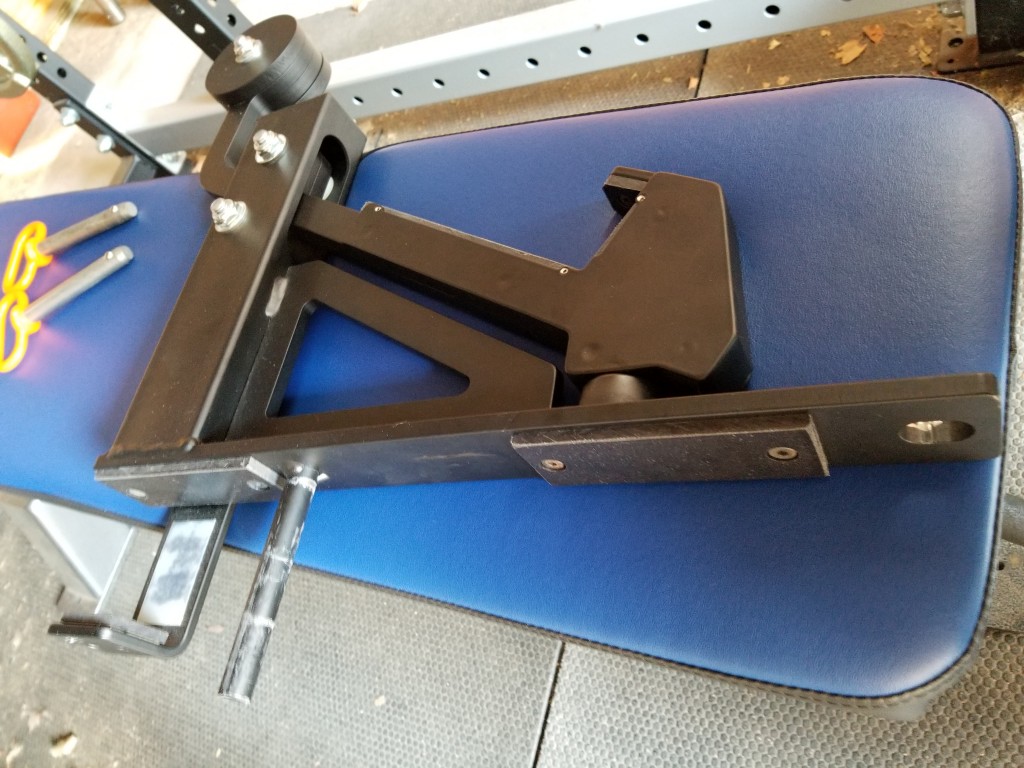
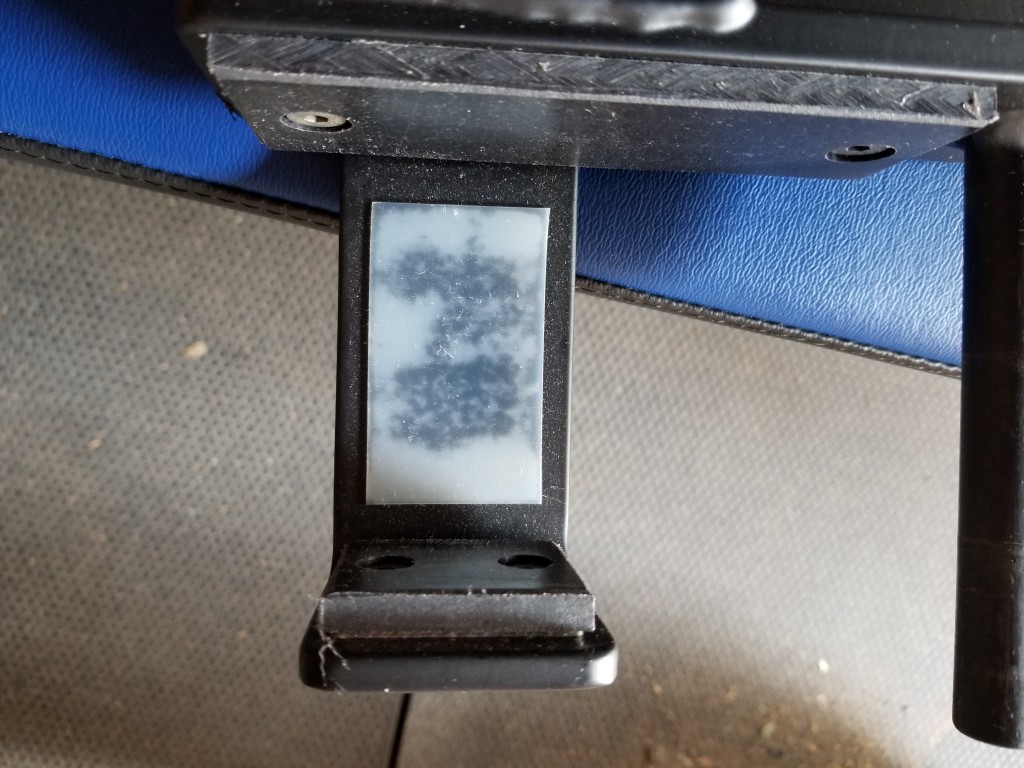
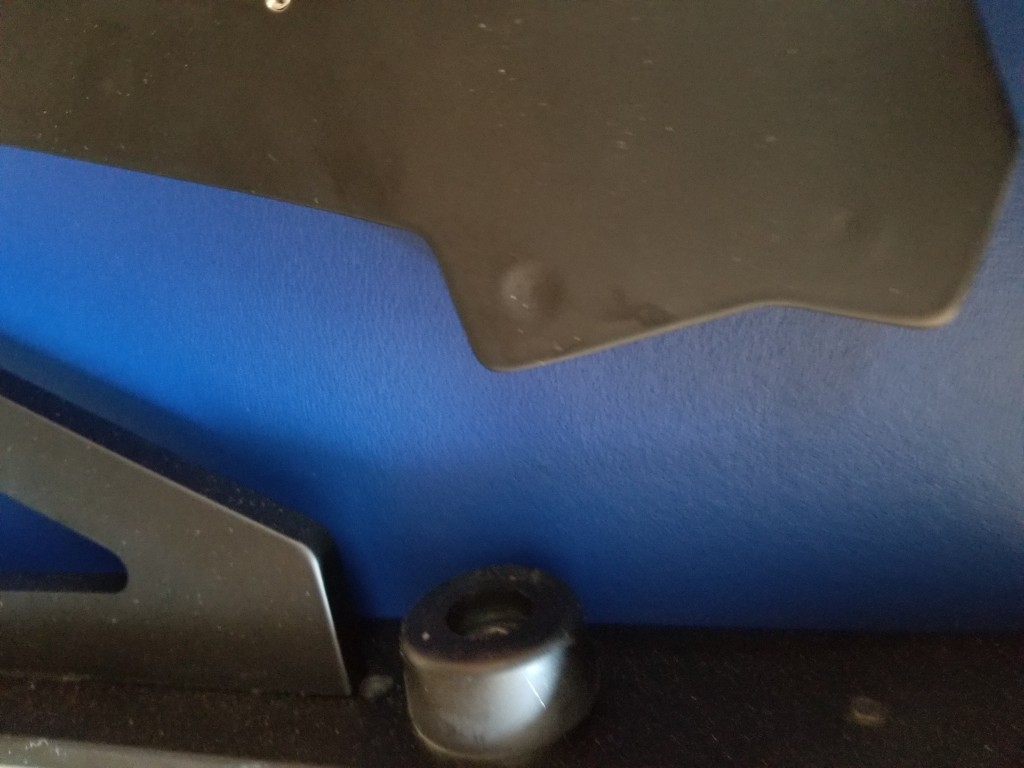
Movements
Here’s some of my thoughts and opinions on the two notorious movements these are primarily used for…
Squats
For squats I personally squat low bar and with a wide grip (based on my broad shouldered stature). Upon setting up and getting under the bar with the monos there’s a bit of a momentum swing as you tighten up to base the bar on your back and un-rack (It takes a bit of getting used to at first, but not too long).
At times you’ll feel the need to step back as you would an un-racked squat out of the regular j-hooks, but there’s no need to with the monos involved… all you gotta do is keep tight with a slight forward swing, un-rack and squat, however there are a few slight caveats to using these for squats in my opinion/observations…
For me personally (since I grip wide on the bar), I notice when re-racking the bar the inner part of the hooks pinch the outer portion of my hands which is definitely not such a favorable feature for me, but for the narrow grip crowd you’ll have no issues with this.
Another thing to note is that when un-racking on squats (aside from a minor learning curve when setting up), due to the angle of the mono hooks and getting used to them, you might accidently bump into the end of the hook from time to time when re-racking, but if you’re mindful and with time it’s barely an issue.
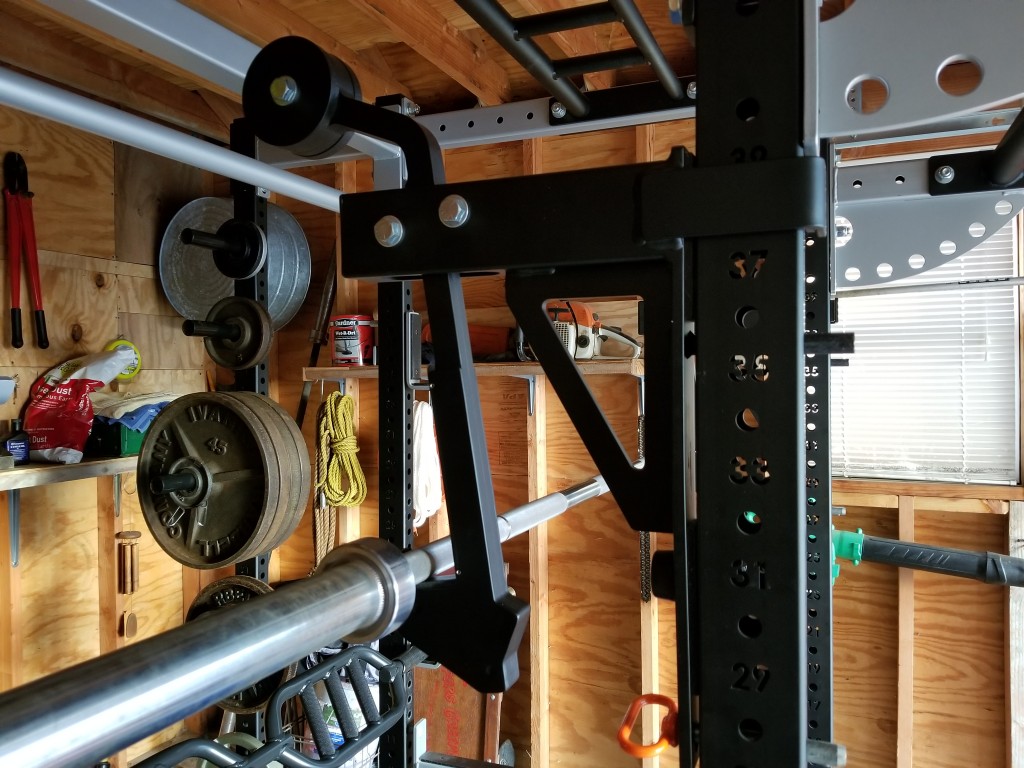
Bench Press
Benching with these are worth their weight in gold in my opinion! They set up perfectly above where you need to bench and un-rack a perfect “Attachment style” hand off of the bar with ease as the hooks get out of the way when un-racking, no shoulder play in setting up as you would when un-racking out of your standard J-hooks when benching.
In my opinion these monolift attachments are worth having just for bench press alone…set your feet and your arch, grasp the barbell tight and get to benching!
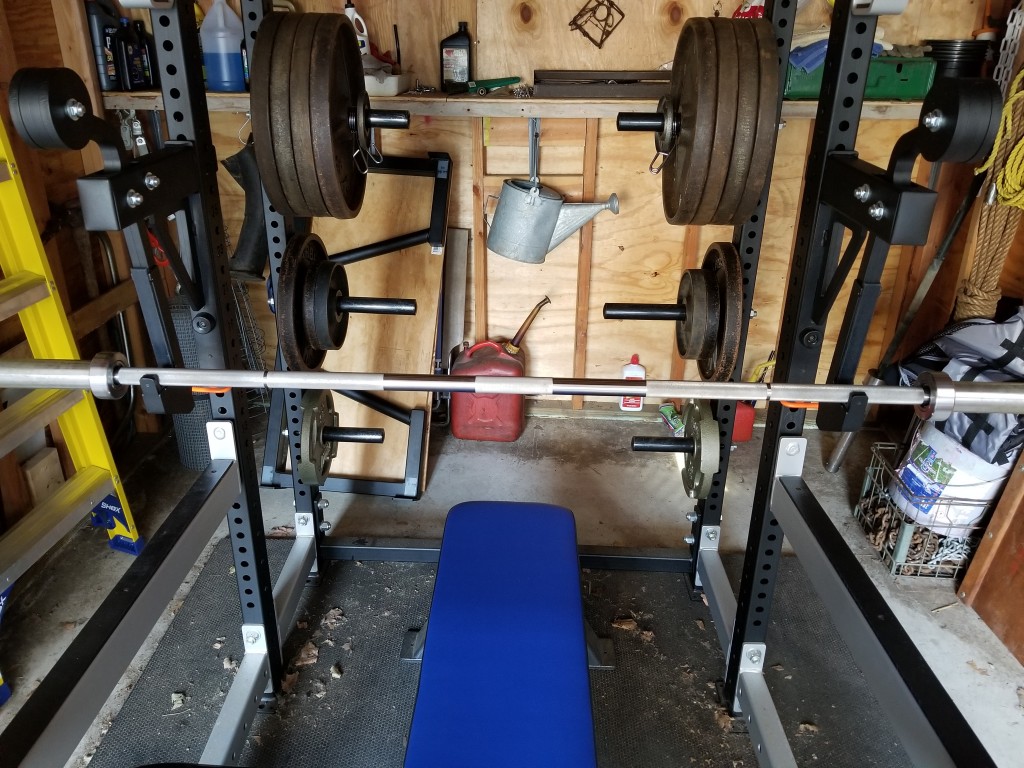
Pros And Cons To Owning A Monolift Attachment
Pros
No need to walk out your squats, just un-rack and get to squatting.
You get the perfect bench press set up with these, no shoulder play as you would with J-hooks when un-racking and getting into position, with monos just un-rack and bench along with the perfect automatic hand off of the bar when lifting alone (as I do fairly often).
Re-racking is easy too with these, especially on bench… in fact, it’s so easy that you might get a bit worried at first as you re-rack the bar back and easily down as it swings/pushes the hooks forward perfectly with the bar ready for another set!
Heavy-duty and pretty much indestructible (The UHMW lined all around the contact points is definitely a welcomed attribute).
Cons
These things could be a bit of a bear to move around and adjust when you wanna just have everything set up and lift! Rogue’s monolift attachment weighs a bit over 30 lbs each hook and I imagine my custom monolift attachment isn’t too far off weight wise.
If you do all your lifts inside your rack and have the standard 30″, or in my case 36″ inside space, the monos could get in the way, or impede your lifting on some movements depending on where they’re placed…for example, if you like keeping things set where they are and ready for the next lift and you set the monos for bench, you won’t be able to squat inside the rack due to the counter balance weight portion sticking out as you sit back to squat you’ll hit that part of the monos, also if you set up for floor lifts inside the rack they can impede your deadlift, or barbell row when set for either the squat, or the bench area (I imagine this being particularly even less convenient if using the bolted version in this kind of situation).
Benching after squats with the monos set in the squat area is a non-issue, if you use them on the outside of the rack with an extra set of spotter arms and space isn’t an issue for you, or if you use them for one specfic lift inside the rack and do your other lift(s) outside the rack with J-hooks then it’s no problem as well.
If you only have one specific lift you focus on each workout day and lift inside the rack then moving them around will be a non-issue too (regardless of the adjustable, or bolted versions).
Tips And Tricks
Due to the nature of the design on these monolift attachments, they’re gonna have to be set to a different numbered hole when attaching them to the upright as opposed to your typical standard J-hook set hole number.
For example I have my J-hooks set to hole 33 for squats, if I switch them out for my monolift hooks then I gotta set them to hole 35 (so two holes higher), for benching I have my J-hooks set to hole 22, but for benching with the monos I have to set them to hole 25 (so three holes higher for bench), since the mono hooks drop down lower and due to the length of them adjusting them higher seems to work.
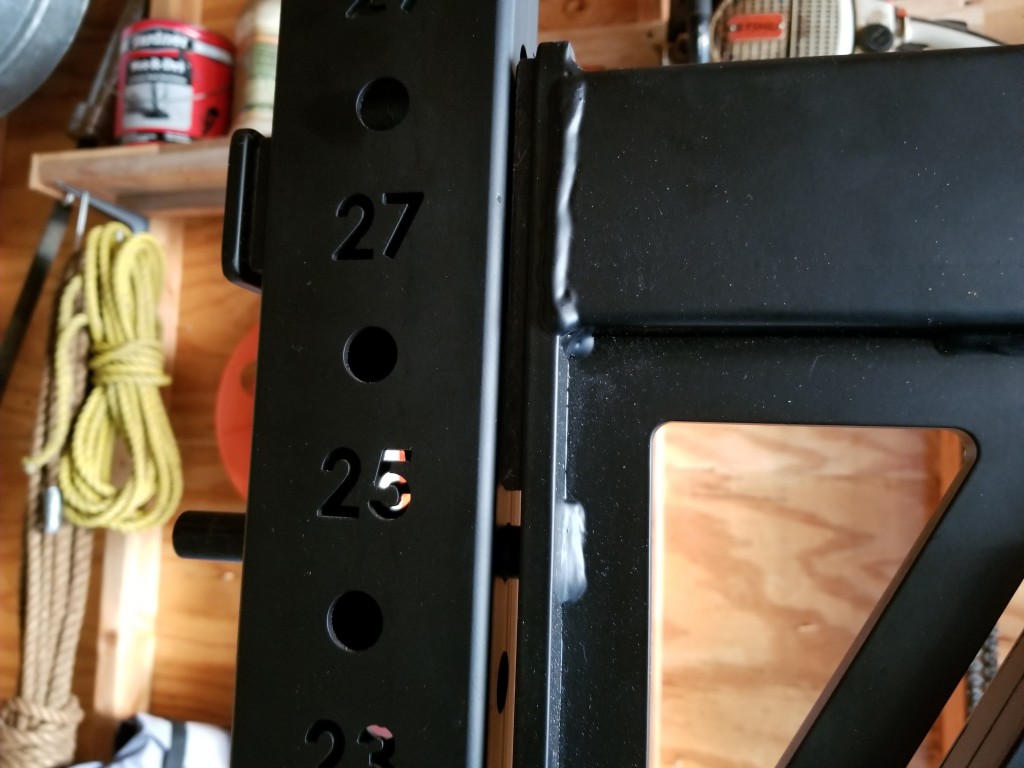
The sheet of steel that wraps around the upright when setting up the monos should be held with the UHMW lined inner portion facing up on the outer side of the upright, lead with the pin going into the proper hole and the mono facing that way, then twist it clockwise for the left one and counter clockwise for the right one for easier set up, once it’s lined up from there place the hitch pin through the hole at the bottom portion if this is your style of monolift attachment.
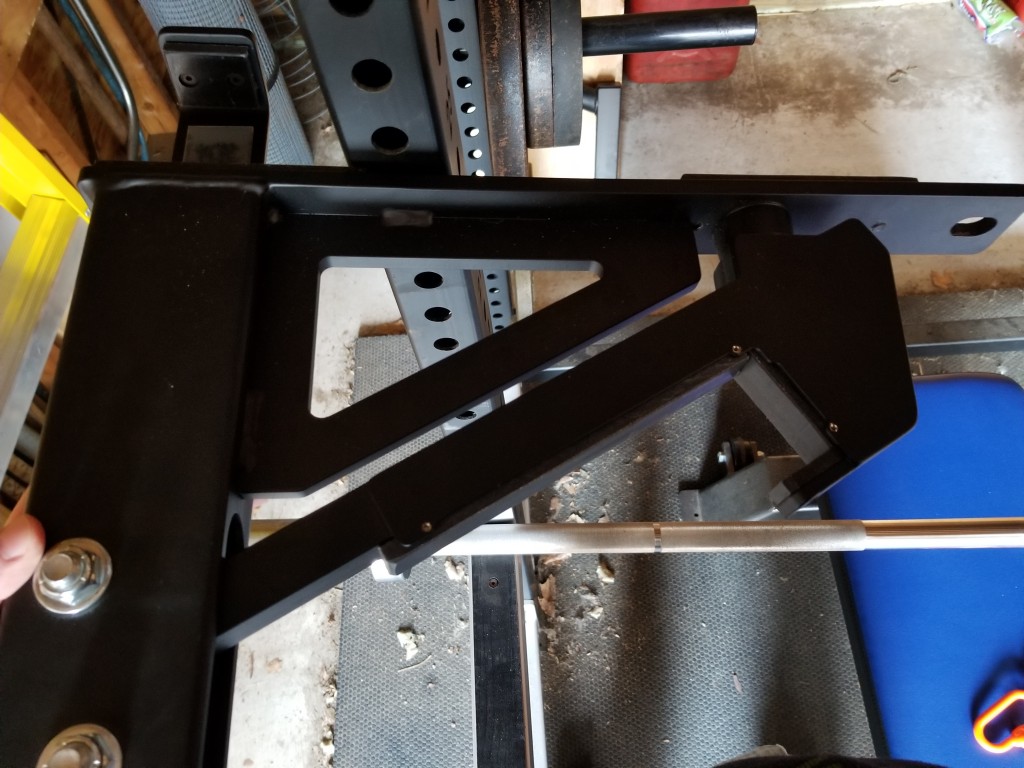
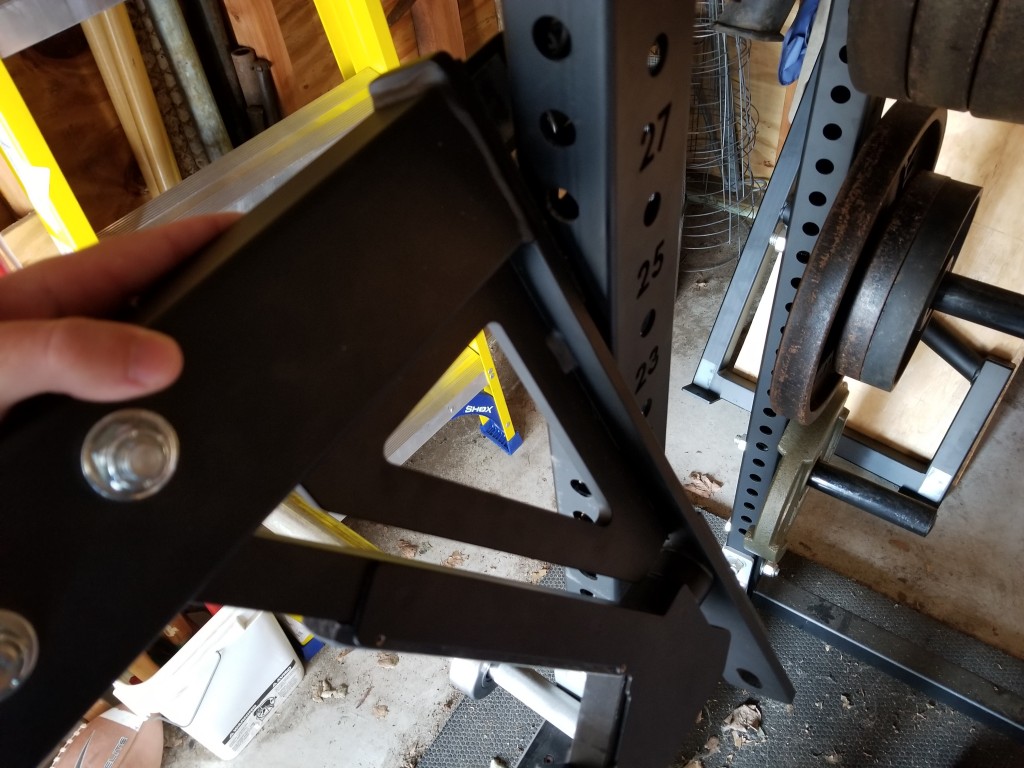
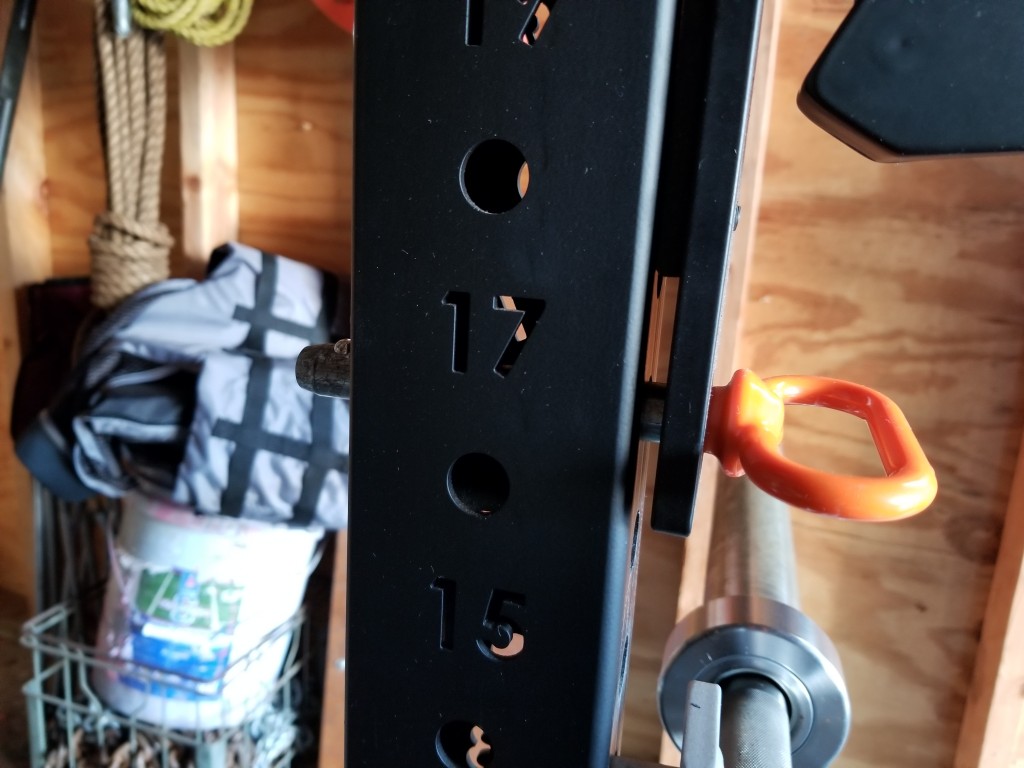
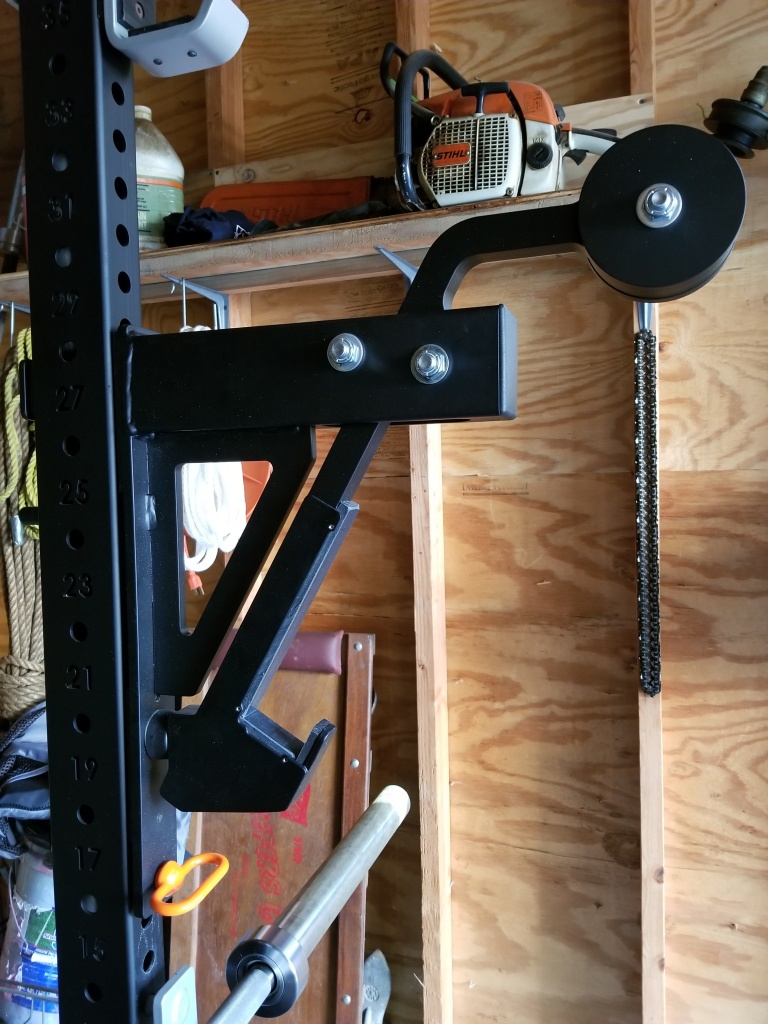
Warm up with lighter weight when you’re in the process of getting familiar and adapted to squatting and benching with these… no need to walkout on squats with these and for benching you might need to set your arch a bit lower on the bench, or just slightly roll your bench out to match where the bar sets out on the monos, for me personally I didn’t really have to move around all that much on bench (the set up felt real natural), you could also even utilize these for floor presses set in your rack to workout your lock out strength.
If you own a rack with good heft, plenty of pull-up bars and/or a hefty K-brace, plate storage and a lower cross-member the monos won’t tip your rack over, nor be a safety hazard… however, if you have a shallow rack with not too much support up top and on the bottom, then it would be wise to bolt it down with these heavy monos attached to it.
Final Thoughts On Whether To Own Monolifts Or Not
After all of the core basics are covered for a home gym, from a luxury standpoint a monolift attachment is cool to have for peace of mind on two of the best lifts…it’s one of the best un-essentially essential items out there!
With the above mentioned though I would definitely recommend that you start with two pairs of J-hooks at first (more compact and easy to move around, plus they give you a feel of having to walk out the squat and set up the positioning for a bench press should you be in a situation of not having the luxury of training with this setup somewhere), then if you feel you want them at a certain point get the monos and see how you like them.
The good news with these, especially quality ones like the custom ones I own, or Rogue’s is that they got a good resale value should you want to flip them if they’re not right for you.
For me, I enjoy them for benching with, but not so much on squats (I don’t mind walking out squats and am accustomed to it, also due to my wide grip I value keeping chunks of my hands intact, so J-hooks are the clear winner for squats for me).
I do all my lifts in the rack so switching them in and out and rotating them into my lifting is a bit of a bear…however when knowing which hole to place them in and how to set them in (See above in the “Tips And Tricks” section) they aren’t too bad, but if I’m pressed for time and want to keep things set then I wouldn’t necessarily throw out my benching set of J-hooks in replacement for the monos, or vice versa.
If you lift alone and want the peace of mind of a hand off on heavy sets, or something automatically set for nagging joint pain and to be set in then the monos could be your ally as well.
All in all, in the home gym, keep what works and keeps you focused and motivated towards your goals on this lifetime adventure we call lifting!
Editor’s Note: For a list of monolifts that may fit your rack, see the power rack attachments and compatibility article.

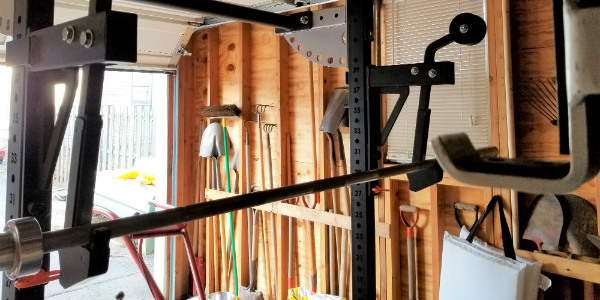
How do the custom monolifts compare to Rogue/Titan’s version?
Also, how did they compare on price?
The custom monolift’s counter balance mechanism up top is a bit more portable/sticks out less than Rogue’s by a few inches and I imagine Titan’s version too (since Titan typically seems to mimic Rogue’s designs to a degree at cheaper prices due to the hardware and not as refined finishes), also the UHMW protected contact areas design is a bit different and where the pin is placed is different on my custom pair than Rogue’s and Titan’s monolift.
I almost went with Rogue’s adjustable infinity series retro fit kit monolifts until the custom fabricator contacted me and offered me his last personal set of monolifts since he didn’t use them much. Since they were slightly used (mainly just cosmetic a little bit of paint scuffed on the pins from use) I got ’em for a few bucks less than Rogue’s and it only made sense to get ’em since I bought my rack at the time from that same guy.
Keep in mind that this fabricator doesn’t make these pieces anymore, so Rogue would be the next best option if going adjustable and if you’re looking for heavy-duty quality.